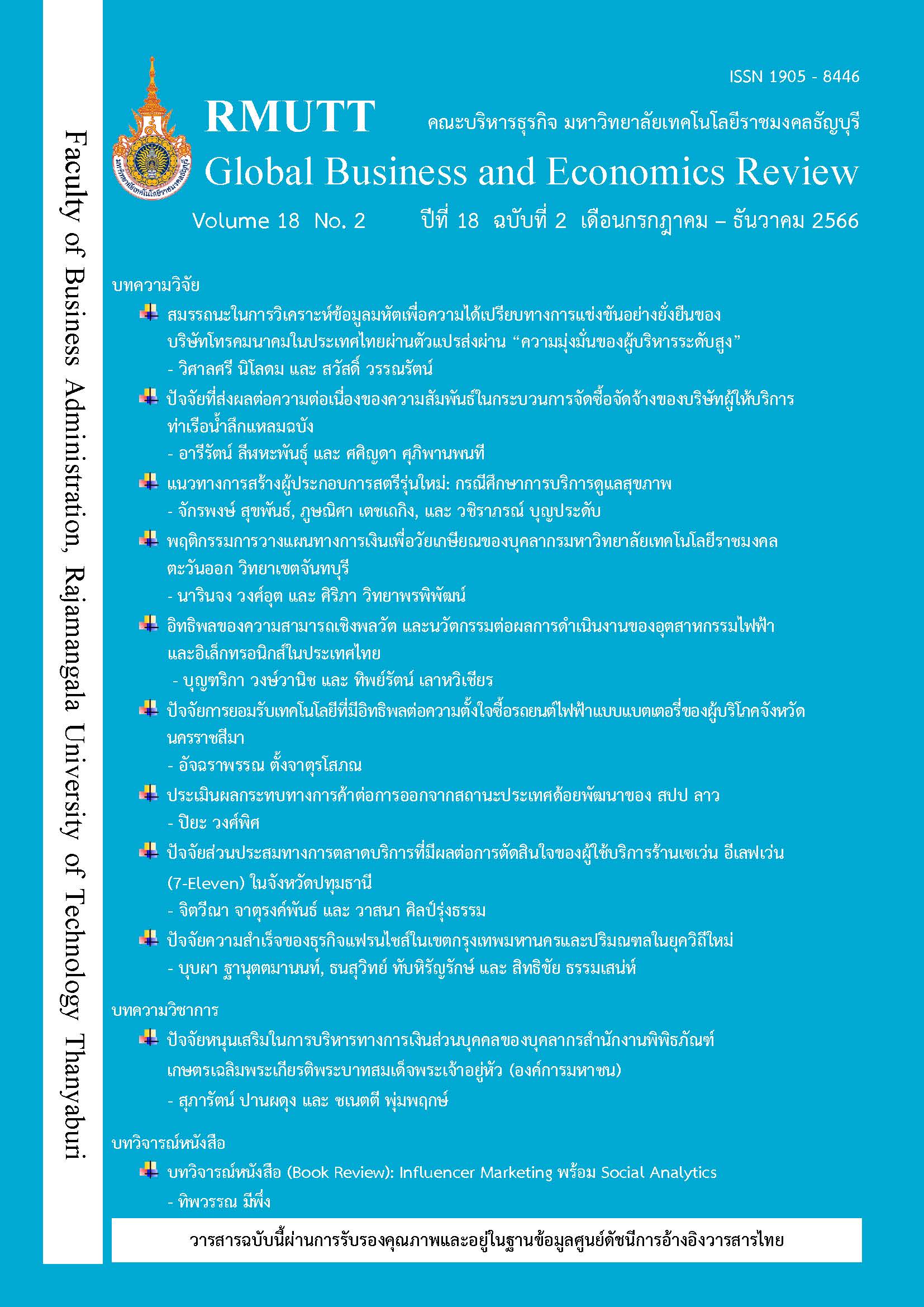แนวทางการสร้างผู้ประกอบการสตรีรุ่นใหม่: กรณีศึกษาการบริการดูแลสุขภาพ
DOI:
https://doi.org/10.60101/rmuttgber.2023.264338คำสำคัญ:
ผู้ประกอบการหญิงใหม่, การบริการดูแลสุขภาพ, แบบจำลองธุรกิจบทคัดย่อ
การวิจัยครั้งนี้มีวัตถุประสงค์เพื่อศึกษารูปแบบของการทำธุรกิจการให้บริการดูแลสุขภาพและนำเสนอแนวทางการสร้างผู้ประกอบการหญิงใหม่ในอำเภอสันทราย จังหวัดเชียงใหม่ ผ่านแบบจำลองธุรกิจ Business Model Canvas ผู้วิจัยใช้ระเบียบวิธีวิจัยเชิงคุณภาพด้วยวิธีการสุ่มตัวอย่างแบบเฉพาะเจาะจง ใช้การสัมภาษณ์แบบกึ่งมีโครงสร้างเป็นการเก็บรวบรวมข้อมูลโดยการสัมภาษณ์เชิงลึก ผู้ให้ข้อมูลหลักประกอบไปด้วยผู้ประกอบการที่ให้บริการด้านการดูแลสุขภาพ จำนวน 10 คน บุคลากรทางการแพทย์ในโรงพยาบาลจำนวน 6 คน บุคลากรทางการแพทย์ในศูนย์สุขภาพชุมชนจำนวน 5 คน บุคลากรด้านการกู้ชีพและกู้ภัยจำนวน 4 คน และบุคลากรด้านการสาธารณสุข จำนวน 5 คน ในเขตอำเภอสันทราย จังหวัดเชียงใหม่ รวมทั้งสิ้น 30 คน ประกอบไปด้วย ผลการศึกษาพบว่ารูปแบบในการทำธุรกิจการให้บริการดูแลสุขภาพสำหรับผู้ประกอบการหญิงสามารถแบ่งได้เป็น 3 รูปแบบคือ 1) ธุรกิจสถานรับดูแลผู้สูงอายุ 2) ธุรกิจการรับส่งผู้สูงอายุ และ 3) ธุรกิจการดูแลผู้สูงอายุที่บ้าน นอกจากนี้จากผลงานวิจัยยังพบว่าแนวทางในการสร้างผู้ประกอบการหญิงใหม่นั้น ต้องมีเข้าเข้าใจพื้นฐานในการดำเนินธุรกิจ ซึ่งมีองค์ประกอบในการพิจารณาดังต่อไปนี้ 1) กำหนดรูปแบบการให้บริการ 2) กำหนดประเภทของผู้ใช้บริการหรือลูกค้า 3) กิจกรรมหลักในการให้บริการ 4) ทรัพยากรหลักในการดำเนินกิจการ 5) การสร้างเครือข่ายกับการบริการที่เกี่ยวข้อง 6) กำหนดแหล่งที่มาของรายได้ 7) มีความเข้าใจต้นทุนในการดำเนินงาน 8) การใช้เครื่องมือสื่อสารที่เหมาะสม 9) รักษาความสัมพันธ์กับลูกค้า
References
Ahl, H. (2006). Why research on women entrepreneurs needs new directions. Entrepreneurship Theory and Practice, 30(5), 595–621. https://doi.org/doi.org/10.1111/j.1540-6520.2006.00138.x
Allen, S., & Truman, C. (2016). Women in business: Perspectives on women entrepreneurs (1st ed.). Routledge.
Amornpinyo, N. (2018). The characteristics of entrepreneurs with successful and sustainable small businesses in Northeastern Thailand. Social Sciences & Humanities, 26(1), 113–128.
Blank, S. (2013). Why the lean start-up changes everything. Harvard Business Review, 91(5), 63–72.
Braun, V., & Clarke, V. (2012). Thematic analysis. In APA Handbook of Research Methods in Psychology (pp. 57–71). The American Psychological Association.
Cardella, G. M., Hernández-Sánchez, B. R., & Sánchez-García, J. C. (2020). Women entrepreneurship: A systematic review to outline the boundaries of scientific literature. Frontiers in Psychology, 11, 1557. https://doi.org/10.3389/fpsyg.2020.01557
Cooney, T. M. (2012). Entrepreneurship skills for growth-orientated businesses (skills development for SMEs and entrepreneurship). OECD. https://www.oecd.org/cfe/leed/cooney_entrepreneurship_skills_HGF.pdf
Department of Business Development. (2019). Elderly care business management quality standards guide. Ministry of Commerce.
Department of Business Development. (2021). Business analysis report. Ministry of Commerce.
Department of older persons. (2022). The elderly statistics in Thailand. Statistics of the elderly who has Thai nationality and the house registration in January 2022. https://www.dop.go.th/th/know/side/1/1/1159
Dong, J., He, D., Nyman, J. A., & Konetzka, R. T. (2021). Wealth and the utilization of long-term care services: Evidence from the United States. International Journal of Health Economics and Management, 21(3), 345–366. https://doi.org/10.1007/s10754-021-09299-1
El-Shal, A., Cubi-Molla, P., & Jofre-Bonet, M. (2022). Discontinuation of performance-based financing in primary health care: Impact on family planning and maternal and child health. International Journal of Health Economics and Management. https://doi.org/10.1007/s10754-022-09333-w
GEM. (2022). Global entrepreneurship monitor 2021/2022 global report: Opportunity amid disruption. The Global Entrepreneurship Research Association.
Hermawan, B., Basalamah, S., Djamereng, A., & Plyriadi, A. (2017). Effect of service quality and price perception on corporate Image, customer Satisfaction and customer loyalty among mobile telecommunication services provider. IRA-International Journal of Management & Social Sciences, 8(1), 62. https://doi.org/10.21013/jmss.v8.n1.p7
Hermawan, F., Wijayanti, S. H., & Aba, F. X. L. (2017). The canvas model as a strategy for Improving financial profits: A casey study of online businesses in Indonesia. Journal of Business and Economics Review, 2(4), 40–44.
Kerr, S. P., Kerr, W. R., & Xu, T. (2017). Personality traits of entrepreneurs: A review of recent literature (Working Paper No. 18–047).
Harvard Business School. https://www.hbs.edu/ris/Publication%20Files/18-047_b0074a64-5428-479b-8c83-16f2a0e97eb6.pdf
Lal, K., & Arora, V. P. S. (2017). Women Entrepreneurship: An overview of Indian scenario. International Journal of Enterprise Computing and Business Systems, 7(1).
Littunen, H. (2000). Entrepreneurship and the characteristics of the entrepreneurial personality. International Journal of Entrepreneurial Behavior & Research, 6(6), 295–310. https://doi.org/10.1108/13552550010362741
Massa, L., Tucci, C. L., & Afuah, A. (2017). A critical assessment of business model research. Academy of Management Annals, 11(1), 73–104. https://doi.org/10.5465/annals.2014.0072
Nair, K. R. G., & Pandey, A. (2006). Characteristics of entrepreneurs: An empirical analysis. The Journal of Entrepreneurship, 15(1), 47–61. https://doi.org/doi.org/10.1177/097135570501500104
OECD. (2019). The missing entrepreneurs 2019: Policies for inclusive entrepreneurship. https://doi.org/10.1787/3ed84801-en
Osterwalder, A. (2004). The business model ontology–A proposition in a design science approach. University of Lausanne.
Osterwalder, A., & Pigneur, Y. (2010). Business model generation: A handbook for visionaries, game changers, and challengers. John Wiley & Sons.
Ruangkrit, S., & Thechatakerng, P. (2015). Characteristics of community entrepreneurs in Chiangmai, Thailand. World Journal of Management, 6(1), 58–74.
Sarfaraz, L., Faghih, N., & Majd, A. (2014). The relationship between women entrepreneurship and gender equality. Journal of Global Entrepreneurship Research, 2(1), 6. https://doi.org/10.1186/2251-7316-2-6
Sibalija, J., Barrett, D., & Subasri, M. (2021). Understanding value in a healthcare setting: An application of the business model canvas. Methodological Innovations, 14(3), 1–13. https://doi.org/10.1177/20597991211050477
Sort, J. C., & Nielsen, C. (2018). Using the business model canvas to improve investment processes. Journal of Research in Marketing and Entrepreneurship, 20(1), 10–33. https://doi.org/10.1108/JRME-11-2016-0048
Sparviero, S. (2019). The case for a socially oriented business model canvas: The social enterprise model canvas. Journal of Social Entrepreneurship, 10(2), 232–251. https://doi.org/10.1080/19420676.2018.1541011
Strawser, J. A., Hechavarríab, D. M., & Passerinic, K. (2021). Gender and entrepreneurship: Research frameworks, barriers and opportunities for women entrepreneurship worldwide. Journal of Small Business Management, 59(1), 1–15. https://doi.org/10.1080/00472778.2021.1965615
Teerawichitchainan, B., Pothisiri, W., Knodel, J., and Prachuabmoh, V. (2019). The situation of Thailand’s older population: An update based on the 2017 survey. HelpAge International.
Thumkosit, U., Meemak, W., & Temchavala, P. (2018). Reform Strategies for Good Governance in Thai Local Government. Journal of Health Science, 27(2), 342–350. https://thaidj.org/index.php/JHS/article/view/2826
Troise, C., & Tani, M. (2021). Exploring entrepreneurial characteristics, motivations and behaviours in equity crowdfunding: Some evidence from Italy. Management Decision, 59(5), 995–1024. https://doi.org/10.1108/MD-10-2019-1431
UNDESA. (2019). World Population Ageing 2019. Ageing. https://www.un.org/en/development/desa/population/theme/ageing/index.asp
van Eijkel, R., Kattenberg, M., & van der Torre, A. (2022). Pricing behavior in long term care markets: Evidence from provider-level data for home help services. International Journal of Health Economics and Management. https://doi.org/10.1007/s10754-022-09334-9
WHO. (2021). Ageing and health. World Health Organization. https://www.who.int/news-room/fact-sheets/detail/ageing-and-health
World Economic Forum. (2020). Global gender gap report 2020 insight report. World Economic Forum.
Yadav, V., & Unni, J. (2016). Women entrepreneurship: Research review and future directions. Journal of Global Entrepreneurship Research, 6(12), 1–18. https://doi.org/doi.org/10.1186/s40497-016-0055-x
Zott, C., Amit, R., & Massa, L. (2011). The Business Model: Recent Developments and Future Research. Journal of Management, 37(4), 1019–1042. https://doi.org/10.1177/0149206311406265
Downloads
เผยแพร่แล้ว
How to Cite
ฉบับ
บท
License
Copyright (c) 2023 จักรพงษ์ สุขพันธ์, ภูษณิศา เตชเถกิง, วชิราภรณ์ บุญประดับ

This work is licensed under a Creative Commons Attribution-NonCommercial-NoDerivatives 4.0 International License.
บทความที่ได้รับการตีพิมพ์เป็นลิขสิทธิ์ของผู้นิพนธ์
ข้อความที่ปรากฏในบทความแต่ละเรื่องในวารสารวิชาการเล่มนี้เป็นความคิดเห็นส่วนตัวของผู้เขียนแต่ละท่านไม่เกี่ยวข้องกับมหาวิทยาลัยเทคโนโลยีราชมงคลธัญบุรี และคณาจารย์ท่านอื่นๆในมหาวิทยาลัยฯ แต่อย่างใด ความรับผิดชอบองค์ประกอบทั้งหมดของบทความแต่ละเรื่องเป็นของผู้เขียนแต่ละท่าน หากมีความผิดพลาดใดๆ ผู้เขียนแต่ละท่านจะรับผิดชอบบทความของตนเองแต่ผู้เดียว







